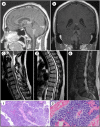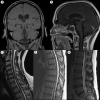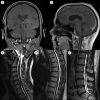Optimum treatment for primary intracranial Ewing sarcoma
- PMID: 32675975
- PMCID: PMC7340410
- DOI: 10.1080/08998280.2020.1755199
Optimum treatment for primary intracranial Ewing sarcoma
Abstract
Ewing sarcoma (ES) is an aggressive, high-grade neuroectodermal neoplasm that frequently manifests in children and young adults. Although ES without osseous involvement most commonly involves paravertebral regions of the spine, it very rarely presents as a primary intracranial tumor. This report discusses a unique presentation of an adult extraosseous ES arising from the pineal region with extension into the third and fourth ventricles and multiple drop metastases to the spine. This case demonstrates the application of current chemotherapeutic and adjuvant management and offers insight into possible treatment modalities for metastasis in an atypical extraosseous ES involving the brain and spine.
Keywords: Chemotherapy; Ewing sarcoma; pineal region tumor; radiation therapy.
Copyright © 2020 Baylor University Medical Center.
Figures



References
-
- Louis DN, Ohgaki H, Wiestler OD, Cavenee WK. WHO Classification of Tumours of the Central Nervous System. 4th ed. Lyon, France: IARC Press; 2016.
-
- Ladanyi M, Lewis R, Garin-Chesa P, et al. . EWS rearrangement in Ewing’s sarcoma and peripheral neuroectodermal tumor. Molecular detection and correlation with cytogenetic analysis and MIC2 expression. Diagn Mol Pathol. 1993;2:141–146. - PubMed
Publication types
LinkOut - more resources
Full Text Sources
